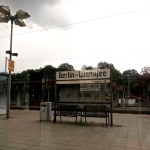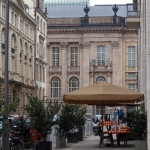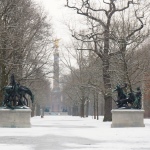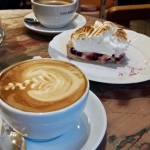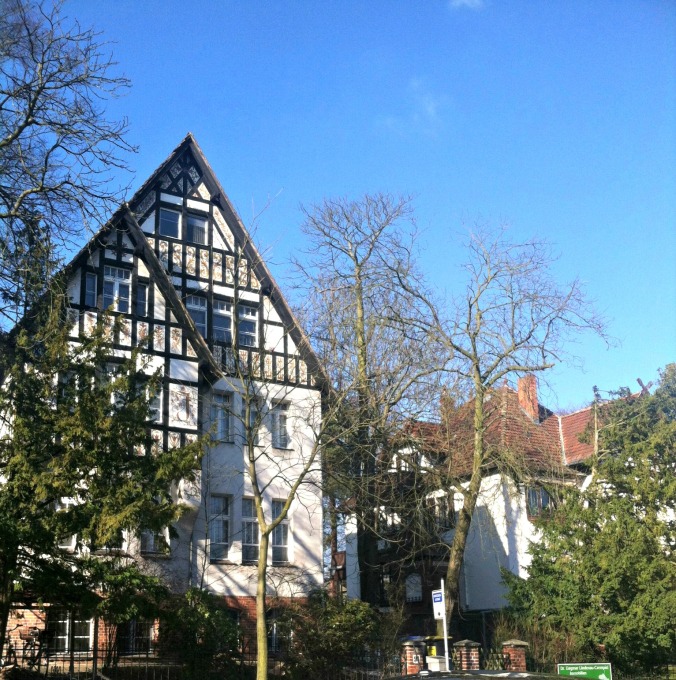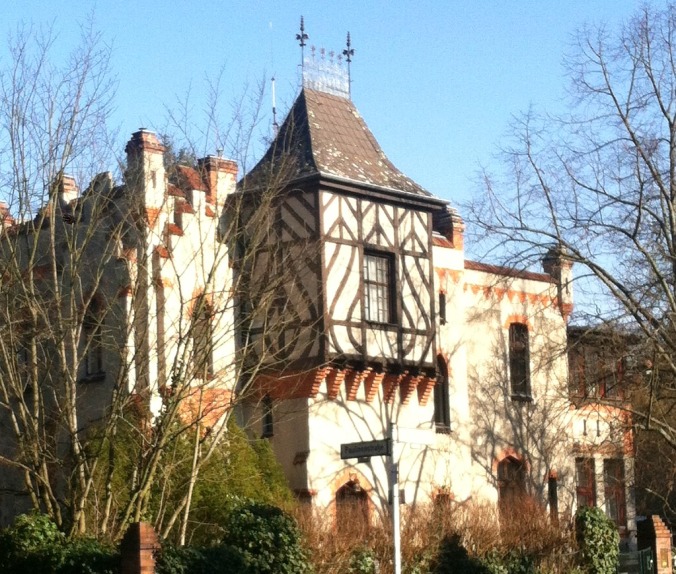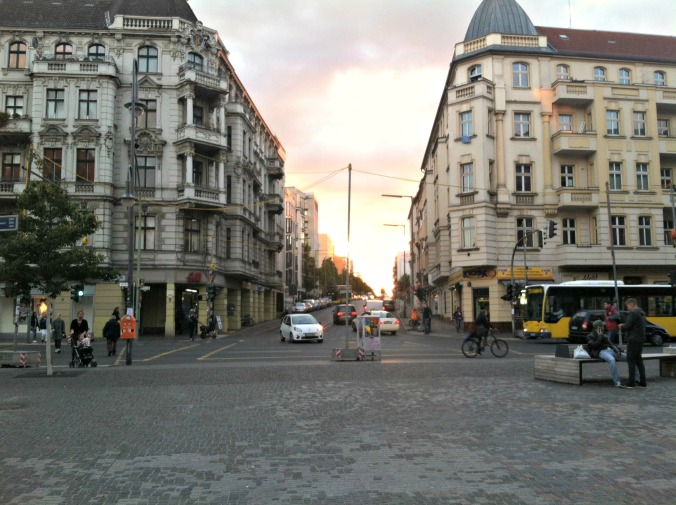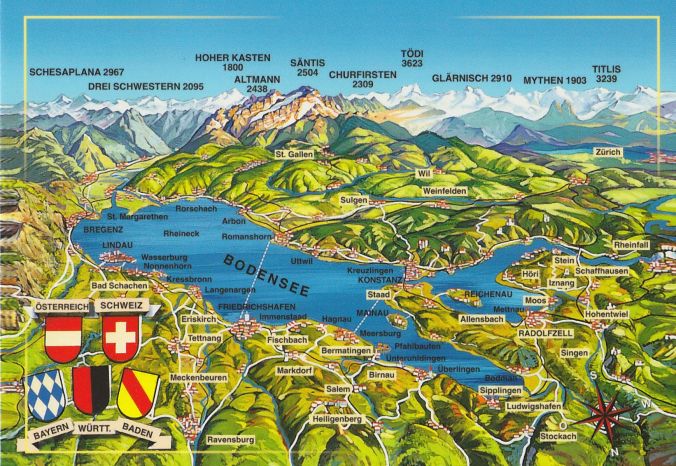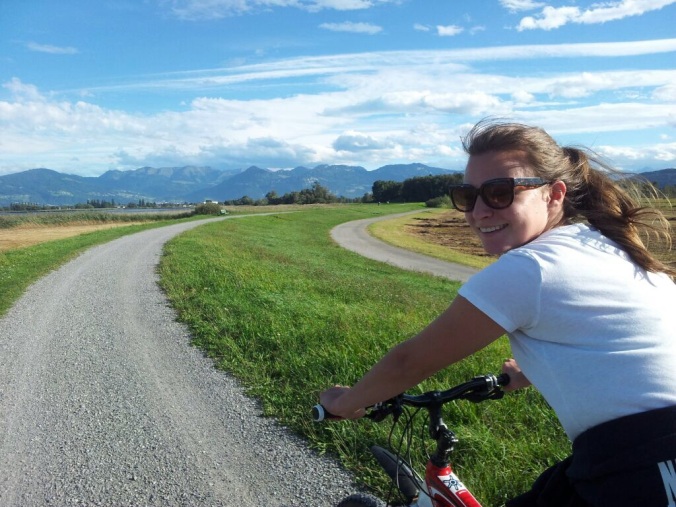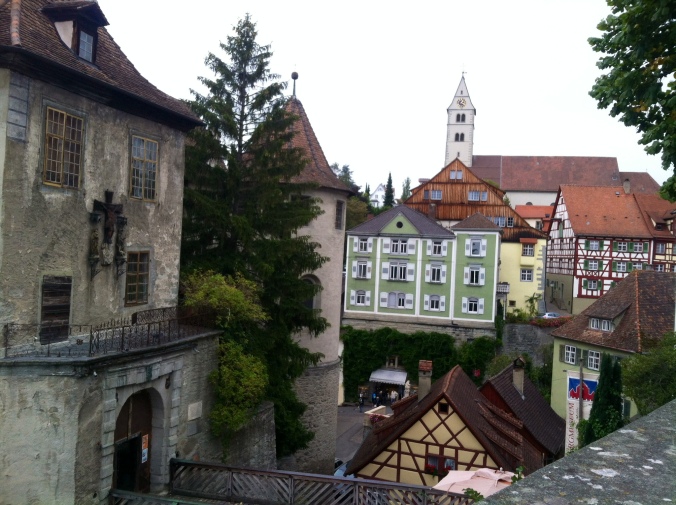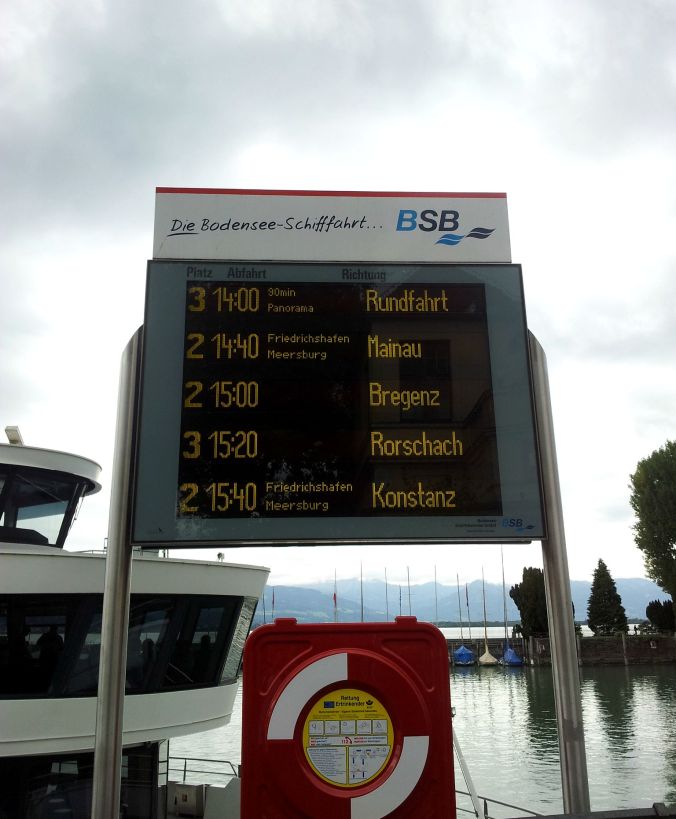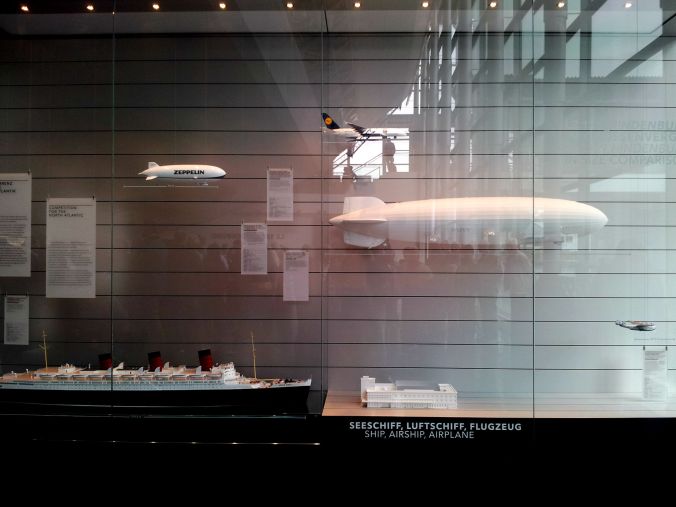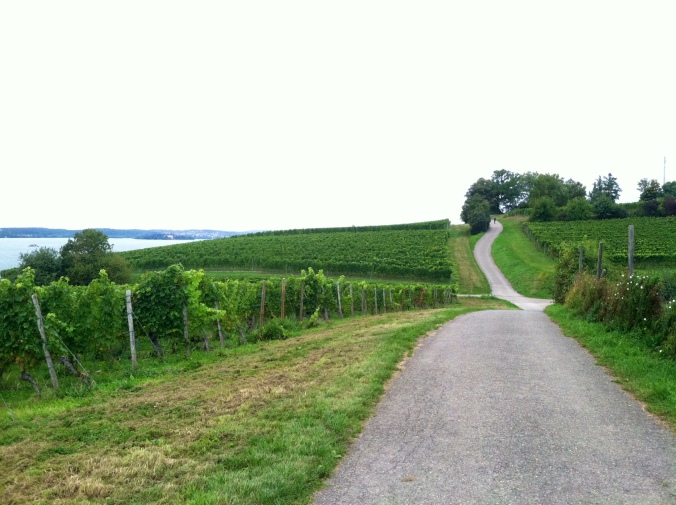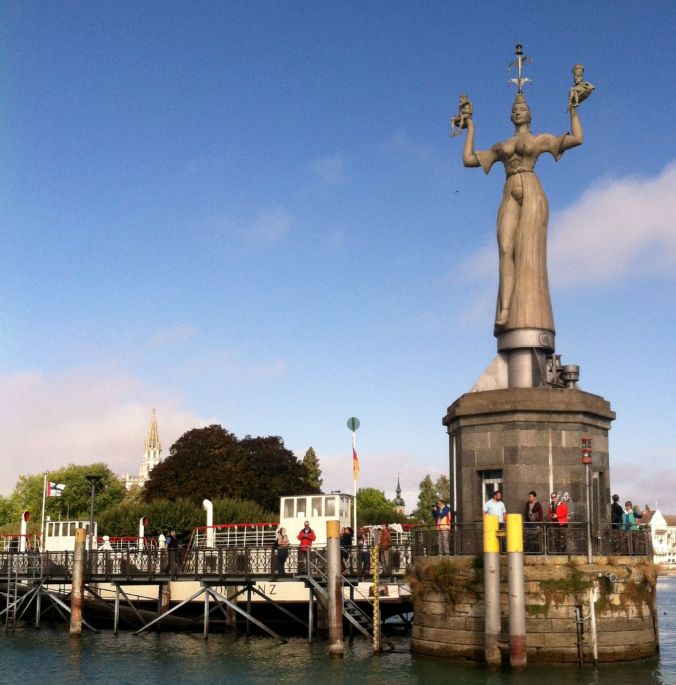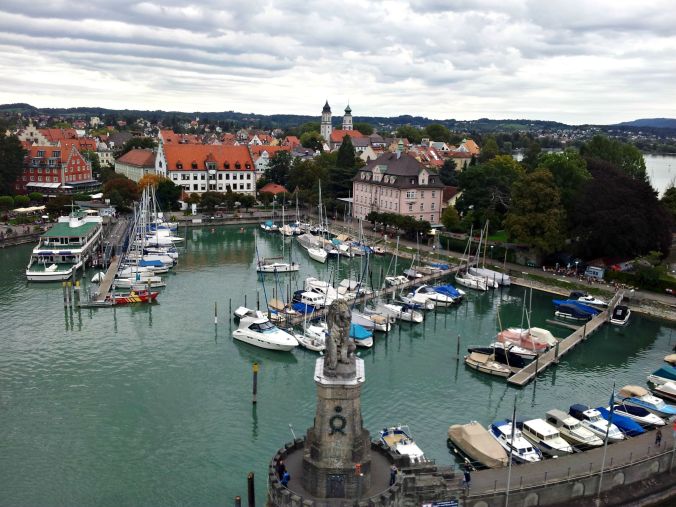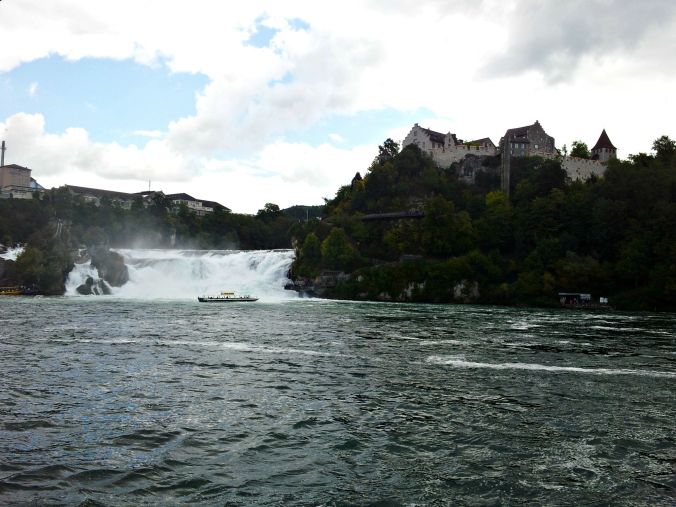How can I best explain to you Berlin?
I’ve spent the better part of a week sifting through my thoughts and I’m convinced that would be an impossible task. For starters, there is no one Berlin. The essence of the city is different in each district, in each neighborhood, on each street. There’s a unique Berlin to be crafted by each of the 3.5 million people who call the city home. And that is the real beauty of Berlin.
So in writing this introduction to Berlin, all I can really hope to do is convey to you my Berlin. All I can offer are snapshots of my everyday. To show the city as I see it—where I go, who I see, why I love living here, and the many unexpected ways in which this enigmatic city has left its imprint on me.
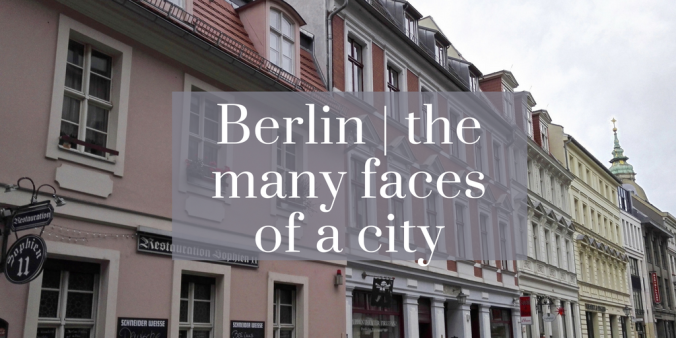
I came to Berlin a little more than a year ago, looking for something to jumpstart my stalled attempt at building a life in Germany. My understanding of the city, acquired from one university class and a weekend visit two years before, was introductory at best. I wasn’t yet able to see beyond the surface, beyond the city’s face: its excess of electronic music, the clubs, the relentless line at Mustafa’s Gemüsekebap, Neukölln and Kreuzberg’s unparalleled popularity, the relics of the postwar history(s) scattered across the city.
But Berlin is so much more complex. It requires you to scratch more than just its surface, to look at things differently, to notice the details. I still remind myself of this everytime I go walking through Berlin’s streets.
Berlin is organic. It’s a city that’s constantly being reimagined. Nuances of meaning are layered one on top of the next: coexisting, blending, battling one another for the right to define the city. Understanding Berlin requires seeing how these different layers touch, seeing the interplay between its grittiness and elegance, the delicate balance of its modernity and the pageantry of old Berlin.
Berlin is a mosaic, the sum of its various pieces—places, people, histories. It’s a city that has something to offer everyone. Edgy clubs, bookstores for conspiracy theorists/Italophiles/anarchists/collectors of first editions, artisanal coffee shops, street festivals, and musicians playing impromptu concerts in barroom basements. But for each second-hand store selling Doc Martens and vintage Levis, there’s its counterpart. Luxury boutiques, Michelin-rated restaurants, teahouses, bars with dress codes, black-tie orchestra performances, and sidewalk cafes that serve Aperol Spritz or any of a dozen other Prosecco aperitifs.
Berlin is inexplicable. I don’t know how, but at some point, while you’re busy trying to build your Berlin—to understand its layers, navigate the twists of its oldest streets, to notice the details uniquely Berlin—you’ll realize that you’ve changed, that Berlin has been quietly rebuilding you.
Snapshots of Life in my Berlin
Below you’ll find a selection of seemingly random snapshots of my Berlin—each one can stand on its own. But when read together, they tell the story of my time in Berlin and illustrate the emotional rollercoaster the last year-and-a-half has been. If you don’t have time to read through them all right now, then click on any one of the pictures to jump directly to the chosen snapshot. Enjoy!
“Never knew before what eternity was made for. It is to give some of us a chance to learn German.” —Mark Twain
Have truer words ever been spoken? Three years of German courses and I’m still constantly bested by “the awful German language”—by its nonsensical genders, its excessive declinations, and rules of formality. But more than just being time-consuming (and a constant source of headaches), the German language has served as the biggest obstacle to feeling like I belong. It has kept me on the outside looking in, kept me shy and quiet and unadventurous at times. And in the beginning, I missed out on a lot of things because of it.
All the little things that are difficult anytime you move to a new place—learning to navigate the city, searching for apartments, landing a job, finding new friends—were that much harder in German. In my first months in Berlin, I messed up a lot. I took wrong trains, kept to myself when classmates were speaking German, missed my bus stop just so I didn’t have to ask people to move and let me off, and came home with only half the items on my grocery list because I didn’t know the German translations (having to make American recipes with German-grocery-store ingredients remains the bane of my existence…).
Each mistake felt like the end of the world and building a life in German still felt hopeless. How was I going to make a life in Germany if I couldn’t make it in young, multicultural, accepting Berlin? How would anyone ever get to know me if they only ever got the abridged German version of me?
After a semester of feeling hopelessly out of place, I decided to do something about it. So I got a job. Every day was a struggle, a seemingly endless string of embarrassing conversations and mistakes that stemmed from my German:
A man came in on my second or third day of opening alone. He looked very friendly for 7 AM, carrying a briefcase and a folded newspaper under his arm. He stepped up to the counter and said something to me. “Coffee from Togo? No, all of our coffee actually comes from Italy,” I replied in German, smiling. Though I did find his choice of Togolese coffee rather than the standard Sumatran, Colombian, or Brazilian as odd, I went with it anyway—what do I really know about coffee-exporting countries? He stared at me, not speaking. Looking back, he was probably trying to figure out what he did to deserve this so early in the morning. Speaking slowly he answered in English, “No. A. Coffee. To-go.” He was really nice about the whole situation and laughed with me about it, but this unbelievably embarrassing conversation stuck with me for weeks…
An older couple came into the cafe on a sunny Sunday when I was working the ice cream counter. This was the worst job to have if the weather was nice because there was always a long line and people are impatient when it comes to ordering ice cream. But at the moment it was just this couple so I was in no rush when I greeted them. The man immediately launched into the most complicated order. “Two cups of two scoops of ice cream. Strawberry. With whipped cr—” “No, no whipped cream! And vanilla and Malaga ice cream, no strawberry,” replied his wife. By the end, their ridiculous order ended up being eight scoops of ice cream and two completely different combinations of nuts, sauces, toppings, and whipped cream—I wouldn’t have been able to remember it exactly even if I hadn’t blocked this horrible encounter from memory. But what I do know with absolute certainty is that neither one of them ordered strawberry ice cream and that they did both want fresh strawberries. And I know this because I had to ask, which prompted the ugliest, most in-your-face encounter I’ve had as an expat. I asked for clarification on whether they were asking for strawberries or strawberry-flavored ice cream because the way he worded it was unclear. And then all hell broke loose. The man went on and on about how this was exactly why foreigners shouldn’t be working here and why the owner’s business was suffering (it wasn’t as far as I was aware). And I had to stand there making their stupid cups of ice cream with a smile…
German distinguishes between an informal and formal you—you either say du or Sie to someone. The former is used if you’re talking to someone your age or younger, your family or someone you know very well. Everyone else is a Sie. And Germans take this formality pretty seriously. (Don’t get me started on titles, social etiquette, and words you can and can’t say to someone you don’t know well enough!) As an English-speaker, this is a foreign concept, which makes it really hard to remember when you’re in the middle of conversations. So in working in a German cafe—a typical one, not the hip, young urban cafes that reject this formality—you use Sie. I had a hard time getting this right at the time. It wasn’t something that I was always conscious of when speaking, but at the same time, it was one of those mistakes I heard as soon as it came out of my mouth. In the beginning, I constantly slipped up and referred to customers by the informal du. Again, most people were nice about it and insisted we continue to speak informally. Then I overcorrected and went through a spell of referring to everyone formally—older customers, people my own age, children ordering ice cream. It got so bad that I even brought Sie home with me, using it with classmates, friends and my boyfriend…
Looking back with some distance between me and all of the embarrassing moments, I can recognize that it ended up being the best thing for me and my German. This job gave my days purpose (…and my nights anxiety) and was the most practical crash course for my German. Most importantly, it taught me to stop being embarrassed and just talk because no matter how many little mistakes you make, people will still understand you. And this has been the greatest, most lasting gift.
I can look back on all of the situations that made me want to cry, that felt disastrous and disheartening and I can laugh at myself. But they’re not just funny stories; they’re markers against which I can more easily see my progress. Today, I approach my mistakes with humor, perspective, and a smile because I can see the difference between the Caitlin from this time last year and me today. I know that eventually, all things pass.
Choose another snapshot?
Reclaiming my Long Lost Independence in the Streets of Berlin-Mitte
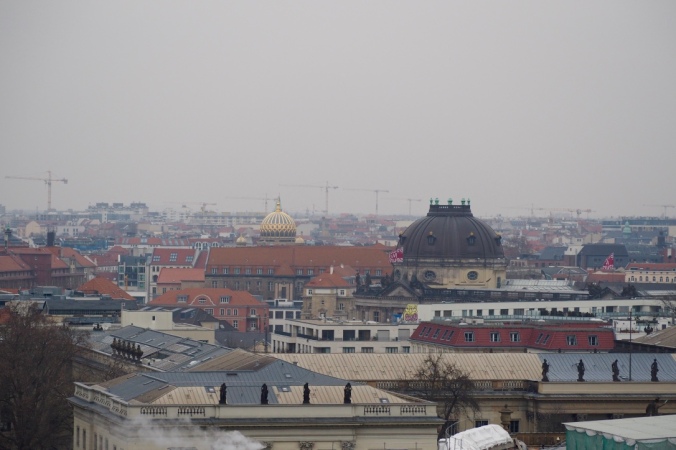
Franz Hessel, a native-Berliner and champion of the French idea of flânerie, writes, “Walking slowly down the bustling streets is a particular pleasure.” I couldn’t agree more. On the days when I don’t have class, I like to take the train into Mitte to walk. It’s an undemanding ride with just one transfer—thirty minutes, give or take.
I generally follow the same route: Gendarmenmarkt, following Markgrafenstraße through Bebelplatz, down Unter den Linden to Pariser Platz, cutting back to Potsdamer Platz and my bus home. But today I think I’ll vary it slightly so I can walk along the Spree.
Stepping out of the Stadtmitte U-Bahn, you’re greeted by the stately Gendarmenmarkt and its trio of buildings: the broad backside of the German Church, the boxy concert hall, and the top of the French Church’s patinaed dome peeking through. On a sunny summer day, the number of people here at any given time would probably surprise you—and it’s not just tourists, but locals and colleagues out for their lunch breaks, too. The outdoor cafes, with their lounge chairs and umbrellas, would be reassembled and spread out around the square. All of the benches would be occupied. And so would each of the steps of all three buildings. The grassy corner areas—remnants of an expansive garden that used to be here before the Nazis came to power—would be hidden under picnic blankets and sunbathers. Yes, there would be people in swimsuits in this stately square. That’s Berlin for you.
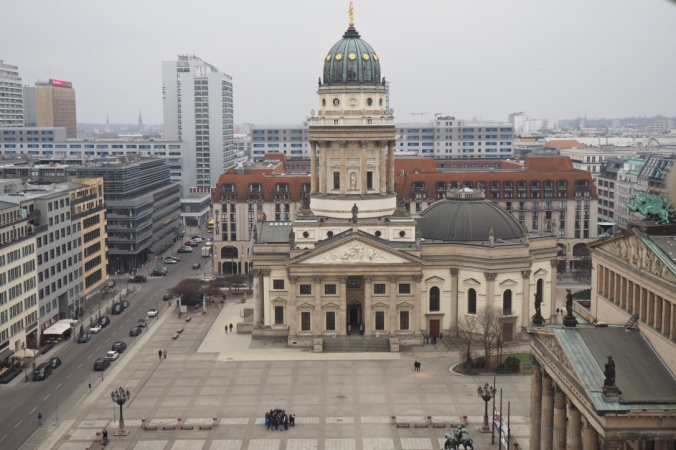
Looking on Gendarmenmarkt’s German Church
But as today is both cloudy and bitterly cold nobody ‘s here. I have free reign of the square. (Well, almost—there’s a couple with a Go-pro to my right.) Standing in the middle of the square, take it all in. But then look beyond it; look at the sliver of space between the concert hall and the French Church. That’s one of my favorite views in Mitte. The contrasting colors—glass and stone, grays, blues, a rosy quartz, and Mitte’s signature cafe au lait color—stand out even more against today’s overcast sky.
A few streets away is Bebelplatz and from here there’s a lot to take in—the expansive square itself, the site of one of the infamous Nazi book burnings; the grand facades of Humboldt University, headquartered in a former Prussian palace; the opera house that, like much of Mitte, is very much under construction and covered in tarps and scaffolding. The neoclassical style, with its ode to the aesthetic of ancient Greece and Rome, is well represented here. The Berlin State Library to the left (and even further left, the Brandenburg Gate) and most of the buildings within eyesight to the right—the Neue Wache, the Crown Prince’s Palace, the Zeughaus. It’s because of the prevalence of these buildings adorned with columns and reliefs, their rooftops guarded by Greek statues, that the moody-looking Berliner Dom, built in a hodgepodge of revivalist styles, sticks out in such sharp contrast.

“That was but a prelude; where they burn books, they will ultimately burn people as well.” Heinrich Heine, 1820
People move about in small clusters, unsure of where to look, of where to go next. Not me—though I have no problem remembering how I felt the first time I roamed alone here in Mitte: afraid someone would stop me, talk to me in German, or even notice me at all. But that’s different now; I’m different now. Now I confidently cross the street, decided on my destination.
But wait! Before we go, take a minute to notice the details that are less obvious.
There’s a cobblestone walkway that follows the curve of the Spree. Its beginning is wedged between the river and the ornate, dusty pink walls of the Zeughaus (the Deutsches Historisches Museum, which I highly recommend, is housed here now). On weekends there is a well-known art market here. On offer are old postcards, paintings, felt hats, photographs, glass sculptures, sketches, and leatherwork. I imagine the price point is a little inflated, but I myself have only ever bought a magnetic bookmark so I really wouldn’t know. (Someone on TripAdvisor says they purchased a 450€ coat here.)
On this walk along the Spree, again I am fascinated with the facades, each so different from its neighbor. The nicest stretch is on the other side along Schiffbauerdamm.
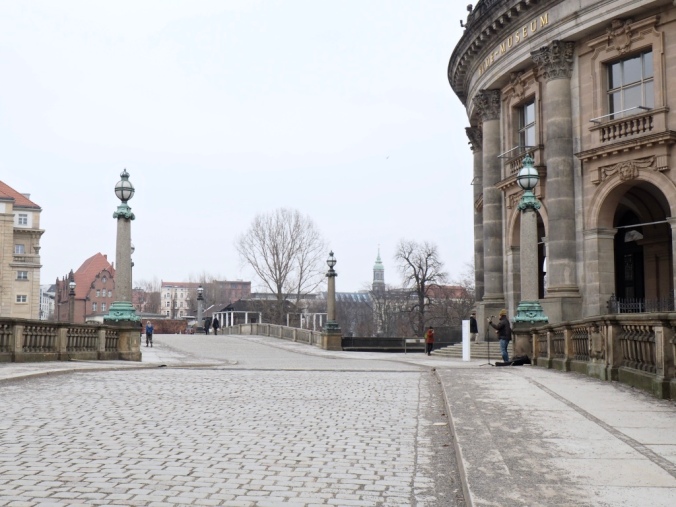

Turning onto Friedrichstraße, one leaves the relative calm of the river and steps into the bustle of this popular shopping street, which runs north-south, crisscrossing its way to Kreuzberg. Walking down the stretch of Friedrichstraße between the river and Unter den Linden is like walking in Manhattan—the buildings are tall and uninterrupted, looking up you barely see the sky, only sandstone, steel, and glass.
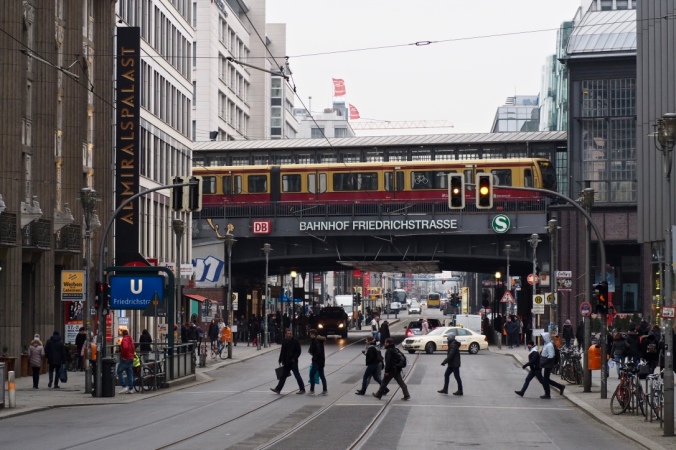
I have no plan to walk to Kreuzberg today. Instead, I turn again onto Unter den Linden, leaving behind the high buildings and the posh arcades sheltering the sidewalks and their shoppers and heading for the most-visited spot in the city: the Brandenburg Gate.
Once forming the western entrance to Unter den Linden and the city, the Brandenburg Gate is now the city’s core—literally and symbolically. Originally built as a symbol of Berlin’s peace and prosperity, the gate’s significance—like that of the city itself—has seen change throughout Berlin’s history. Nevertheless, the Brandenburg Gate’s importance has never faltered. It has served as the spot through which history’s victors and villains have marched—the Hohenzollerns, Napoleon, the Prussians, Germans, the Nazis, and all Berliners upon reunification—a place of protest, a symbol of peace and unity. It’s an image of endurance.
Walking through the gate I take a left, following the edge of Tiergarten towards Potsdamer Platz and the bus that’ll take me home.
Choose another snapshot?
Reflections from a Snowy Oasis in the Middle of Berlin

Winter in Berlin has a hazy, muted look to it—like you’re looking at everything through a filter. And it’s bitterly cold. It’s the heavy kind of cold that settles deep into you, the kind that can’t be stopped, no matter how many layers you wear. Even so, I rewrap my scarf tighter around my neck in an attempt to force the cold of today away. Although it isn’t snowing at the moment, the white-blanketed sky gives the impression that it could start anytime. I hope it does. If I have to brave these subzero temperatures, I want some kind of consolation.
The ground is slick—still covered in last week’s now-frozen rain. Luckily, I was a gifted a warm pair of winter boots for Christmas and they have excellent grip. Still, it’s a relief to find a spot of pure snow where I can exchange timid steps for quick strides and the satisfying crunch they make.
Tiergarten—Berlin’s largest park—looks very different in the winter, bigger somehow. Gone are the tall, leafy trees and in their places these bare ones with knotty, bare branches that seem to twist right up to the heavy, white sky. There is white everywhere, except for the evergreen leaves of bushes that line the trails and the water’s edge.

It has its own kind of charm—just like the city. It may have an odd, atypical beauty, but it’s peaceful here.
I often walk here in Tiergarten, and yet I’m always surprised that this exists in the middle of Berlin—and right around the corner from Zoologischer Garten, one of the city’s major arteries, no less. There’s no noise from the traffic, just birds. None of the tall commercial buildings in sight, just trees and sky and white. There is room to breathe, room to forget for a few minutes that you’re in Germany’s biggest city. And then in fifteen minutes you can be enjoying a coffee, singing karaoke somewhere, or eating really good Pho. I love that.
Over the last year, I’ve found myself thinking about where I’ll be in a year or two—what career to pursue and how, whether I wanted to stay in Berlin, Germany, or move back to the US.
And then, last month I had to undergo unexpected brain surgery. Of course, there was a momentary fear of dying and leaving behind the people I love. But even more than that, there was also a wave of regret—for not unapologetically pursuing every single thing I’d ever wanted to do, for not saying enough ‘thank you’s, ‘I appreciate you’s, and ‘I love you’s, for not having appreciated the little joys in the everyday, for not having more time in Berlin.

And now—now that I get another day in Berlin, another snowy walk through the city’s “woods”, I’m pretty sure I have the answer to the question that’s been on my mind for months. I’m not ready to leave this city. (If I’m being honest, the decision did become a little easier with the current state of things in America.) Berlin has given me a lot already—it’s helped me figure out who I am, and given me permission to be unapologetically me. Living here has made me tougher, made me appreciate the hard work that’s gone into building a life in Germany, and it’s shown me that success can come in a variety of shapes and sizes. I can find joy in the littlest of things and experiences, and ultimately, I’m a happier, better person for it. I’m already not the same person I was just a year-and-a-half ago, but I’m sure Berlin has a lot more to gift me.
Choose another snapshot?
Finding Joy in the Little Things: Chasing after Gemütlichkeit, the German Hygee
While the world is chasing after the Danish hygee, Germany is content to continue embracing its beloved equivalent: Gemütlichkeit. “Cosy”, the closest English equivalent, doesn’t do the concept justice; it relies too heavily on the sense of touch, which fails to capture the emotion of the word—the feeling of comfort, belonging and contentedness. Like hygee, Gemütlichkeit conjures up images of winter storms, a lazy day spent inside with friends, knit blankets, sweatpants, just-brewed coffee and cheese danishes, finishing a good book, and woodburning stoves that burn all day.
But it’s how these things make you feel that really defines this idea. How they make you feel calm, comforted, and completely at peace in that moment—like you’re exactly where you’re supposed to be. And this perfectly sums up how I feel about Berlin and my life here now (finally, after a year of trial-and-error!).
There’s one place more than any other that, for me, is the total embodiment of Gemütlichkeit.
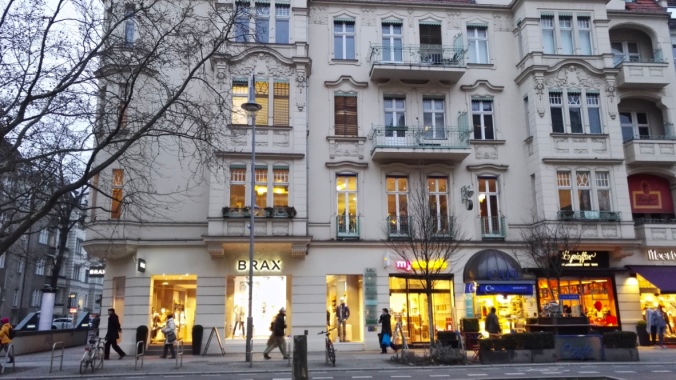
From its second-story perch, Cafe Baier overlooks the bustle of a Saturday on Schlossstraße.
The stairway to my favorite cafe—all marble, gold, and mirrors from top to bottom—is tucked away behind a small pickup-window-style bakery. It’s a literal hole in the wall, a sliver so small that it’s easy to miss if you don’t know what you’re looking for. Upon entering, it’s like stepping back in time, into what I imagine a 20th-century Viennese coffee house to be like—marble floors, crown moldings and painted ceilings, art-covered walls, an impressive selection of newspapers to choose from, tiny tables decorated with vases of flowers and silver sugar bowls, customers who stay for hours to discuss current events, the newest bestseller, or the latest gossip with the waiters.
Immediately upon entering, I head straight to the cakes on offer: heaping trays of cherry, rhubarb, and plum cobblers topped with thick layers of crumble, various cheesecake combinations, boozy Black forest cakes, and tarts filled with currants and topped with crème brûlée.

In the winter garden, tucked away from the crowded tables and hecticness of the main dining room, something about it reminds me of my grandma’s kitchen (this undoubtedly lends itself to the feeling of Gemütlichkeit). The small, round tables—a similar shade of pink marble to the staircase—are piled high with scarves, newspapers, and cups of milky coffee. The walls’ built-in shelves are covered in old, tin canisters, antique cookbooks, and plants with vines that tumble down from their pots. The stained glass windows above the tables are covered in the same white lilies and dark green glass just like the one in my grandma’s kitchen.
You’d think it would be chilly here so close to the french doors, but it isn’t. The room is the embodiment of gemütlich—with the radiators turned on and lights dimmed, the soothing murmur of conversation, cushioned chairs, the sweet smell of cakes, and my enjoyable company—so much so, that who needs a fire burning in the corner.
But there is one thing missing: slices of cake and milky coffees of our own. When they arrive, we settle into the generously-portioned slices of cakes and a conversation about the new art museum opening in Potsdam.
Choose another snapshot?








